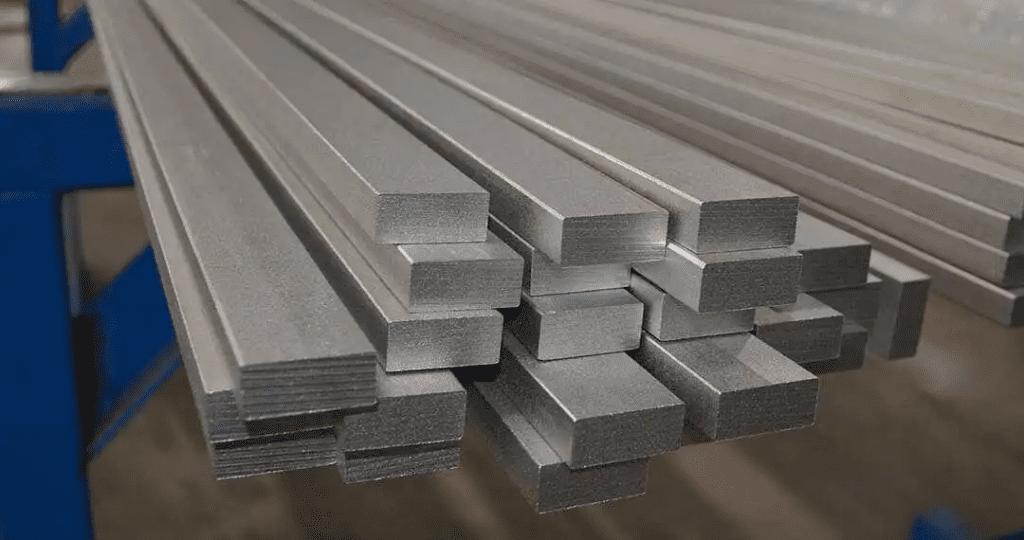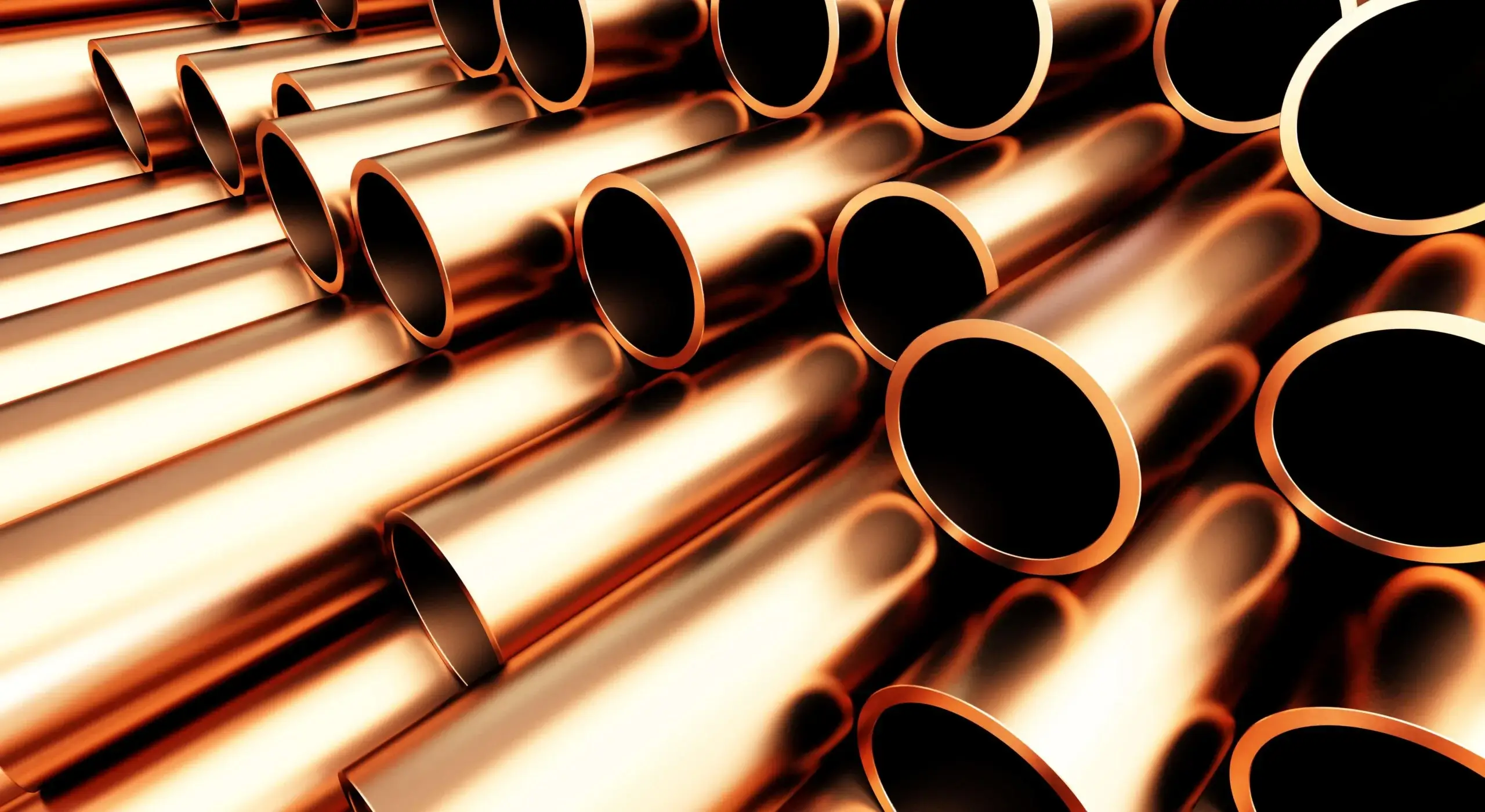When it comes to selecting a metal that can conduct both heat and electricity efficiently, copper is the obvious choice. That’s why it is considered the standard of electrical conductivity for other metals. In a home environment, copper is not as likely to corrode as it is in industrial settings, where factors such as oxidized acids, compounds of sulfur and ammonia, and oxidizing heavy-metal salts tend to speed up corrosion. This is why it’s often used as the base metal for all the electrical and thermal products we use in our daily lives.
For industrial applications, it’s important to protect against corrosion in more extreme environments—this is where oxygen-free copper can become an invaluable material. To help you make the right choice for your application, we discuss the differences between pure copper vs. oxygen-free copper and list the properties of each.
What Is Pure Copper?
When a metal has a minimum copper content of 99.3%, it is known as commercially pure copper. However, such coppers are very soft and ductile in nature. That’s why other alloying elements are often added to copper to optimize its properties for a wide range of usage. However, in terms of electrical conductivity, even 0.05% of arsenic impurity can decrease copper’s conductivity by 15%. In this regard, oxygen-free copper offers mechanical strength coupled with high conductivity, all in one.
What Is Oxygen-Free Copper?
Oxygen-free copper (OFC) is copper that has gone through an electrolytic refinement process to remove all but a trace level of oxygen. It’s the purest commercial copper grade available, containing 99.99% copper with a minimal amount of impurities, and is highly recommended for applications requiring superior conductivity and connectivity, such as superconducting wires, PCBs, X-ray tubes, vacuum interrupters, rotor bars, and motor coils.
Oxygen-free copper has:
- A rich conductivity profile.
- High immunity to hydrogen embrittlement.
- Superior cryogenic properties.
- Excellent malleability.
Oxygen-free copper is available in the following three grades:
- C10100 (OFE): 99.99% pure copper with 0.0005% oxygen content
- C10200 (OF): 99.95% pure copper with 0.001% oxygen content
- C11000 (ETP): 99.9% pure copper with 0.02% to 0.04% oxygen content
|
Buy Certified High-Quality Metals for Industrial Solutions |
||
|
New Aluminum |
New Steel |
New Stainless Steel |
 |
 |
 |
| Reliable supply: Consistent, certified aluminum stock you can trust. High-quality material: Superior-grade aluminum for precision needs. Custom cuts: Accurate cuts down to thousandths of an inch. |
Durability and strength: Reliable for projects needing long-lasting, tough materials. Cost-effective: Quality steel that offers strength without breaking the bank. Custom cutting: Precise cuts tailored to exact needs with top-tier cutting tools. |
Sustainability: Highly eco-friendly as the most recyclable metal on earth. High durability: Resistant to corrosion and wear, ensuring long-lasting performance. Custom precision cuts: Tailored to your specifications with quick, accurate results. |
Comparing Pure Copper vs. Oxygen-Free Copper
Let’s compare the purest oxygen-free copper grade (C10100) with Chromium Zirconium Copper (CuCrZr) that closely resembles pure copper (Cu: 98.6%-99.4%). The table below compares some important metal characteristics of pure copper vs. oxygen-free copper to help you acknowledge their application differences.
| General Properties | OFC | CuCrZr |
| Cold formability | Excellent | Good |
| Hot formability | Excellent | Good |
| Annealing | 700°F to 1200°F | Below 1450°F |
| Electrical conductivity | 101% IACS | 82% IACS |
| Thermal conductivity (Btu/sq. ft/ft. hr./°F at 68°F) | 226 | 187 |
| Machinability rate | 20% | 20% |
| Machining Properties | OFC | CuCrZr |
| Soldering | Excellent | Good |
| Brazing | Excellent | Fair |
| Gas shielding arc welding | Good | Fair |
| Oxyacetylene welding | Fair | Not recommended |
| Coated metal arc welding | Not recommended | Fair |
| Seam welding | Not recommended | Not recommended |
| Butt welding | Fair | Fair |
| Hot forgeability | 65% | Unknown |
| Corrosion Resistance | OFC | CuCrZr |
| Atmospheric | Good | Good |
| Hydrogen Embrittlement | Excellent | Good |
| Marine water | Excellent | Good |
| Stress crack | Good | Good |
| Electrolytic | Good | No data |
Due to reduced oxygen content, OFC offers excellent formability and higher electrical conductivity than pure copper. Although there are some minor differences in machining characteristics between pure copper vs. oxygen-free copper, they display some common machining challenges.
Machining Challenges With Pure Copper Alloys
Pure copper and OFC offer exceptional conductivity and high corrosion resistance, but they are difficult to machine as compared to oxygen-bearing coppers. Copper alloys with high purity levels are highly ductile. The chips stick to the tool during machining and are hard to remove; thus, the tool has to exhibit more force with each pass to get the job done. As a result, tool wear is also high.
To form needle-like, discontinuous chips while machining OFC, fabricators add chip-breaking elements such as lead, sulfur, and tellurium. However, these may reduce the electrical conductivity of the alloy if the elements are not used within certain specific requirements.
The machining properties of OFC are more or less similar to oxygen-bearing copper alloys with a homogeneous profile. Heterogenous copper alloys tend to have better machinability.
Purchase Precisely-Cut Metals For Any Application
Industrial Metal Service has been supplying a wide variety of metals to fabricators, including pure and oxygen-free copper alloys, for more than two decades. We also can provide exotic metals such as titanium, nickel, Invar, molybdenum, and Hastelloy for your unique applications. We offer unbeatable prices, whether you need new, mill-sourced metals or verified metal remnants.
Fabricators and machinists can also take advantage of our state-of-the-art industrial sawing equipment to receive precision-cut, machine-ready materials, saving on material waste, floor space, and costly in-house sawing setups.
 Angle
Angle Cast Plate
Cast Plate Diamond Plate
Diamond Plate Flat Bar
Flat Bar Plate
Plate Round Bar
Round Bar Square Bar
Square Bar Square Tubing
Square Tubing Round Tubing
Round Tubing Angle
Angle Channel
Channel Diamond Plate
Diamond Plate I Beam
I Beam Round Bar
Round Bar Sheet
Sheet Square tubing
Square tubing Round Tubing
Round Tubing Rectangular Tubing
Rectangular Tubing Plate
Plate Rectangular Bar
Rectangular Bar Rectangular Tubing
Rectangular Tubing Round Bar
Round Bar Sheet
Sheet Square Bar
Square Bar Square Tubing
Square Tubing
